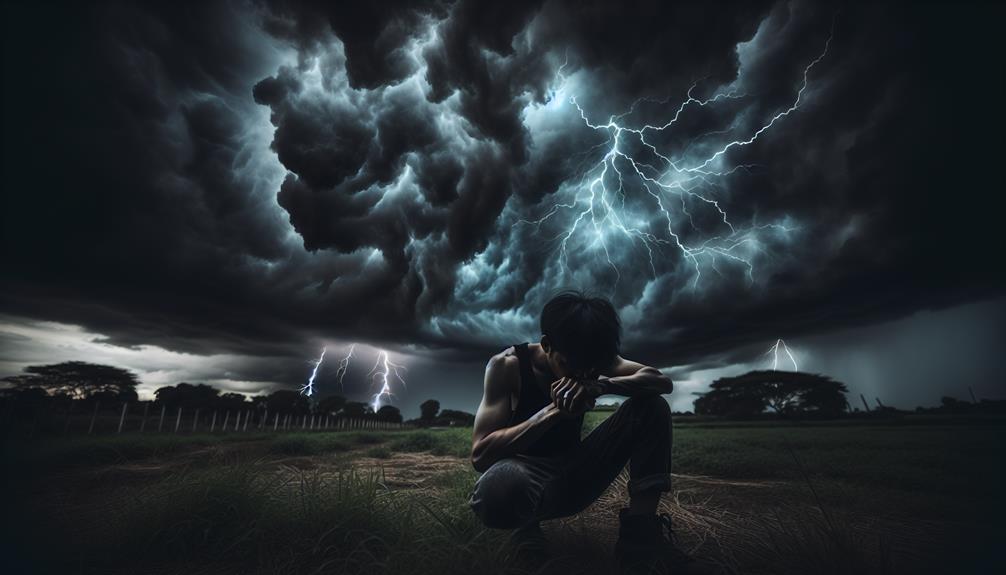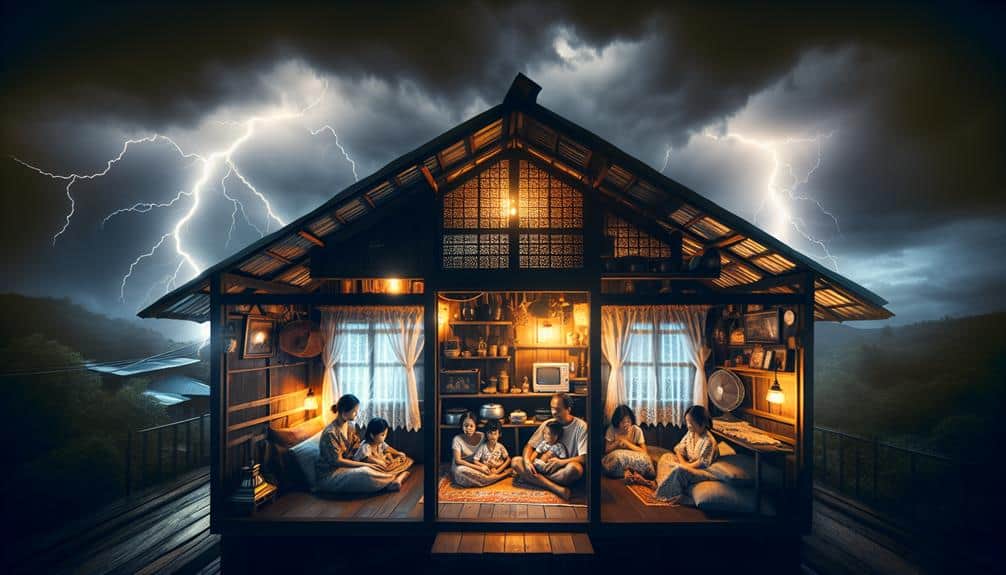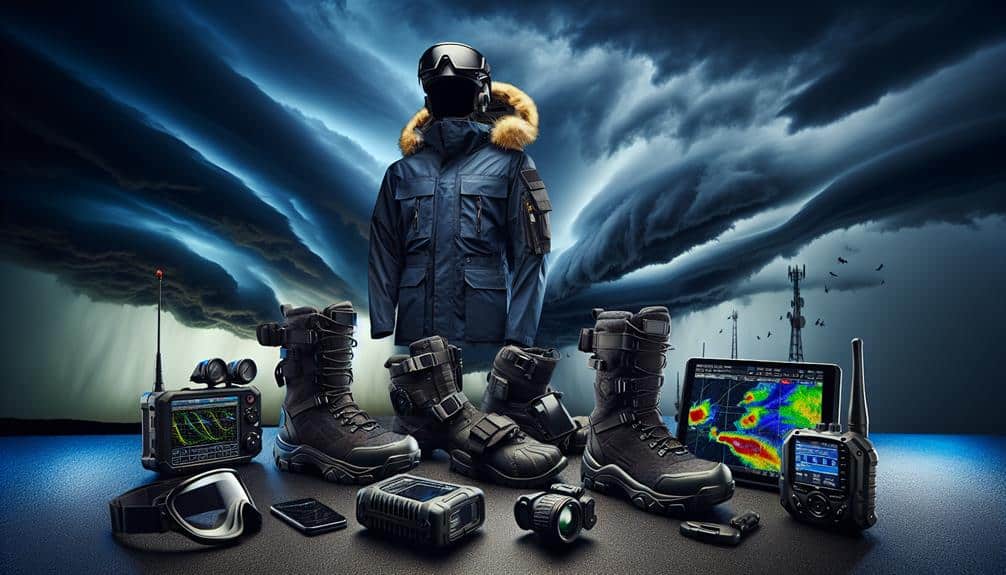During lightning storms, we should prioritize safety using these data-driven measures. Staying indoors greatly reduces the risk of being struck, with lightning causing 27 fatalities annually in the U.S. The 30/30 rule helps by advising us to stay inside until 30 minutes after the last thunderclap. Avoiding water sources, windows, and tall structures helps minimize electrical conduction risks. Unplugging electronics prevents lightning-induced surges. Seeking low ground, avoiding metal objects, and staying off corded phones decrease shock hazards. Utilizing weather alerts optimizes our preparedness. Adopt these practices for improved protection during lightning storms. Explore further techniques for thorough safety strategies.
Key Points
- Stay indoors and follow the 30/30 rule to reduce the risk of lightning strikes.
- Avoid water sources like sinks and showers, as they can conduct electricity.
- Disconnect electronics to prevent damage from lightning-induced power surges.
- Seek low ground and avoid tall structures and isolated trees.
Stay Indoors
Staying indoors during a lightning storm greatly reduces our risk of being struck by lightning. According to the National Weather Service, lightning strikes cause an average of 27 fatalities and hundreds of injuries annually in the United States. Implementing effective lightning safety strategies is vital for minimizing these risks.
When we hear thunder, it's necessary to follow thunderstorm precautions immediately. The 30/30 rule advises us to seek shelter if we can't count to 30 before hearing thunder after seeing lightning. Once inside, we should stay away from windows, doors, and any conductive materials. It's not just about avoiding direct strikes; lightning can travel through wiring and plumbing, posing indirect hazards.
Staying within a structurally sound building is one of the best measures we can take for our safety. Cars with metal roofs also provide good protection, acting as Faraday cages. However, it's important to avoid open structures like gazebos or sheds.
Using these data-driven approaches, we effectively reduce our exposure to lightning-related dangers.
Avoid Water Sources
While sheltering indoors offers significant protection, we must also avoid water sources during a lightning storm to prevent electrical conduction risks. Water acts as a highly efficient conductor of electricity. When lightning strikes, the electrical current can travel through plumbing systems, posing severe hazards. To maintain optimal lightning safety, we should refrain from using sinks, bathtubs, and showers during electrical storms.
Scientific data underscores the importance of this precaution. The National Weather Service reports that electrical conduction through water accounts for a significant proportion of indoor lightning injuries. By avoiding water sources, we minimize the risk of electrical shock and potential injury. It's vital to remember that even washing dishes or doing laundry can be dangerous due to the conductive properties of water.
Furthermore, it's essential to avoid touching wet surfaces, as they can also conduct electricity during a lightning storm. We might think staying indoors grants us total safety, but understanding and avoiding specific risks like water sources enhances our protection.
Let's prioritize our freedom to move and live safely by adhering to these scientifically-backed lightning safety measures. Our vigilance during electrical storms ensures we stay secure and unharmed.
Stay Away From Windows
Windows pose significant risks during lightning storms as they can shatter from nearby strikes or conduct electrical currents. To guarantee our safety, we need to prioritize window safety and understand the science behind these hazards.
Data shows that glass can break under the pressure of a lightning strike, and metal window frames can act as conductors for electrical currents, leading to indoor protection failures.
Let's break down some essential steps for maintaining electrical safety and enhancing our indoor protection:
- Close All Windows: Confirm all windows are securely closed to prevent wind-driven rain and debris from entering our living spaces, which can cause additional hazards.
- Stay at Least Three Feet Away: Maintain a safe distance from windows to avoid injury from shattered glass or electrical conduction in case of a nearby lightning strike.
- Use Window Treatments: Install heavy curtains or blinds to act as a barrier against shattered glass, providing an extra layer of protection.
- Avoid Direct Contact: Refrain from touching metal window frames or sills, as they can conduct electricity during a storm.
Disconnect Electronics
In addition to maintaining a safe distance from windows, we must also disconnect electronics to prevent electrical surges and potential damage during lightning storms. Lightning strikes can cause power surges that may overload our electronic devices, leading to costly repairs or replacements. It's essential to implement effective lightning protection measures.
One of the primary safety precautions involves unplugging electronic devices such as computers, televisions, and kitchen appliances. Although surge protectors can offer some level of protection, they're not foolproof against the immense energy of a lightning strike. By physically disconnecting our devices, we ensure an additional layer of safety.
Data from the National Lightning Safety Institute indicates that electrical surges account for significant annual damages to household electronics. To mitigate this risk, we must take proactive measures. Surge protectors can be a part of our strategy, but the most reliable method remains unplugging devices altogether.
Furthermore, we should consider installing whole-house surge protectors for thorough lightning protection. These devices can safeguard our entire electrical system, offering peace of mind and reinforcing our freedom to live without fear of electrical damage.
Avoid Tall Structures

During a lightning storm, it's crucial to prioritize avoiding tall structures like trees and buildings. Data indicates that lightning is more likely to strike elevated objects, so seeking lower ground is essential.
Staying indoors and maintaining distance from windows and tall objects further reduces the risk of lightning-related injuries.
Seek Lower Ground
When a lightning storm approaches, we should immediately move away from tall structures to minimize the risk of a direct strike. This practice is a cornerstone of lightning safety, especially during outdoor activities.
Tall structures, such as trees and buildings, act as natural lightning rods because of their height and conductivity. By seeking lower ground, we greatly reduce our chances of being in the path of a lightning strike.
Here are four key steps to follow:
- Identify Lower Terrain: Move to valleys, ditches, or any lower areas in the landscape. These spots are less likely to be struck by lightning.
- Avoid Isolated Trees: While it might seem safe, isolated trees are particularly perilous during a storm. Instead, opt for emergency shelters that are properly grounded.
- Stay Away from Water: Water bodies are highly conductive. If we're near lakes, rivers, or pools, it's essential to move away quickly to a safer, lower area.
- Avoid Metal Objects: Metal conducts electricity. Items such as fences, railings, and even metal camping gear should be avoided during a lightning storm.
Stay Indoors Safely
It's necessary that we stay indoors during a lightning storm to reduce the risk of being struck by lightning. According to the National Weather Service, lightning can strike up to 10 miles from a storm, making indoor protection essential for our safety.
When indoors, we must avoid tall structures such as chimneys and large appliances, as they can conduct electricity if struck. It's crucial to stay away from windows and doors since these points can facilitate electrical conduction.
We should also refrain from using wired electronic devices, as lightning can travel through electrical systems, posing a notable risk. Our homes should be equipped with proper lightning safety measures, including surge protectors to safeguard electronic equipment. Data from the Lightning Protection Institute indicates that homes with these systems experience significantly fewer damages.
Additionally, we should avoid contact with plumbing, given that water pipes are excellent conductors of electricity.
Distance From Trees
Staying away from tall structures like trees is crucial because they're prime targets for lightning strikes. When lightning storms are imminent, our tree distance safety precautions can make the difference between safety and danger.
Trees, with their height and moisture content, attract lightning, making them hazardous during storms.
To make sure we're minimizing tree hazards during lightning storms, let's follow these steps:
- Maintain a Safe Distance: Keep at least 30 feet away from any tall trees. Lightning can jump from a tree to a person standing nearby, posing a significant risk.
- Avoid Single Tall Trees: Isolated trees are more likely to be struck by lightning. If we're in an open area, stay clear of lone trees and seek lower ground.
- Seek Proper Shelter: If we're caught outdoors, the safest option is to move to a substantial building or a hard-topped vehicle. Trees aren't reliable shelters.
- Stay Low: If no shelter is available, crouch low to the ground, minimizing our contact with the ground and reducing our profile.
Use a Lightning Rod
Utilizing a lightning rod greatly reduces the risk of structural damage by safely directing electrical surges into the ground. We can greatly mitigate potential fires and electrical failures by installing these rods on our homes or buildings.
The primary lightning rod benefits include safeguarding against strikes that could otherwise cause catastrophic damage. These rods act as the first line of defense, intercepting the strike and channeling the electrical energy away from the structure.
When considering lightning rod installation, it's vital to ensure proper placement and connection. The rod should be mounted at the highest point of the structure to maximize protection. It connects to a network of conductors and grounding electrodes designed to dissipate the electrical charge efficiently.
Data shows that properly installed lightning rods can decrease the likelihood of lightning-induced damage by up to 90%.
Moreover, the National Fire Protection Association (NFPA) provides guidelines for installation, emphasizing the importance of professional assessment and compliance with safety standards. By adhering to these protocols, we preserve both our property and our freedom to live without the constant worry of lightning strikes.
Let's leverage this technology to maintain our autonomy and secure our environments.
Seek Low Ground

When we're caught in a lightning storm, it's essential to seek low ground to minimize risk.
Research indicates that hilltops and ridges are prime targets for lightning strikes, while valleys offer safer refuges.
Avoid Hilltops and Ridges
Frequent lightning strikes on hilltops and ridges make it important to seek lower ground during a storm. Elevated areas are prime targets for lightning, greatly increasing the risk of a direct strike. By descending to lower terrain, we can reduce our exposure to this electrifying threat.
Here are key lightning storm precautions to keep in mind when encountering hilltops and ridges:
- Monitor Weather Conditions: Before heading to higher elevations, always check the latest weather forecasts. Lightning storms can develop rapidly, so staying informed is essential.
- Plan Escape Routes: Identify and familiarize ourselves with the quickest descent paths from any hilltop or ridge. This foresight can be lifesaving when a storm approaches.
- Avoid Isolated Trees and Structures: Lightning is attracted to the tallest objects. When on high ground, steer clear of isolated trees, poles, or structures to minimize risk.
- Stay in Groups: Although dispersion reduces the chance of multiple casualties, staying within visual and auditory range of others ensures that assistance is available if needed.
Use Valleys for Shelter
Seeking shelter in valleys significantly decreases our risk of lightning strikes by leveraging the natural protection provided by lower terrain. Valleys act as natural shields because lightning tends to strike the highest points in an area. By positioning ourselves in lower ground, we effectively minimize our exposure to these perilous electrical discharges.
When seeking safety, we should consider the terrain and surroundings. Mountain caves offer additional protection, but we must make sure they're deep enough to shield us from potential ground currents. It's vital to avoid shallow overhangs which mightn't provide adequate protection.
In forested areas, the dense forest canopies can offer a degree of safety by acting as a protective barrier. However, we should avoid standing directly under isolated tall trees, as they're more likely to attract lightning strikes. Instead, finding a cluster of smaller trees within a valley offers a safer option.
Data from the National Weather Service indicates that lower terrain reduces lightning-related injuries significantly. By making informed choices and seeking out valleys, mountain caves, or clusters of smaller trees under forest canopies, we effectively enhance our safety during lightning storms while maintaining the freedom to explore and enjoy nature.
Stay Off Corded Phones
Using corded phones during a lightning storm greatly increases the risk of electrical shock and injury. When lightning strikes, it can travel through electrical wiring and reach any connected devices, including corded phones. This makes phone usage during storms a significant lightning safety concern.
To minimize our risk and maximize our freedom to stay safe, let's consider the following critical points:
- Electrical Conductivity: Corded phones provide a direct pathway for lightning to enter our homes, increasing the likelihood of electrical shock.
- Data from the National Weather Service: According to their reports, approximately one-third of lightning-related injuries indoors are due to phone usage during storms.
- Alternative Communication: Utilizing cell phones or cordless phones, which aren't connected to the house's wiring, can mitigate this risk effectively.
- Precautionary Measures: Unplugging unnecessary devices and avoiding the use of electrical appliances during a storm can further enhance our safety.
Avoid Metal Objects

In addition to avoiding corded phones, we must also steer clear of metal objects during lightning storms to reduce the risk of electrical conduction. Metal is a highly conductive material, which means it can easily carry the electrical charge from a lightning strike to us, significantly increasing the chance of injury or fatality.
Data from the National Weather Service indicates that nearly one-third of lightning-related injuries occur due to contact with metal objects. Items such as bicycles, golf clubs, and even metal fences can become dangerous conduits. Our lightning safety strategy should prioritize minimizing contact with these objects.
Furthermore, indoor metal objects, such as plumbing fixtures, can also pose a risk. Research shows that water and metal pipes can conduct electricity from a lightning strike up to 100 feet away. This means that showering, washing dishes, or even touching faucets during a storm is hazardous.
Follow Weather Alerts
To guarantee our safety during lightning storms, we must follow weather alerts rigorously. Enabling emergency notifications, monitoring local broadcasts, and using weather apps provide timely and critical updates.
These measures enhance our awareness and preparedness, greatly decreasing the risk of harm.
Enable Emergency Notifications
Staying informed through emergency notifications and weather alerts significantly enhances our ability to take timely and appropriate actions during lightning storms. By leveraging technology, we can achieve higher levels of lightning awareness and emergency preparation. Real-time updates empower us to make informed decisions, guaranteeing our safety and that of our loved ones.
Here are four key steps to enable emergency notifications effectively:
- Download a Reliable Weather App: Choose an app with high user ratings and real-time updates. Make sure it covers lightning alerts and integrates seamlessly with our device's notification system.
- Enable Location Services: Activate location services on our devices to receive precise alerts based on our current location. This guarantees we receive the most relevant and timely information.
- Set Up Custom Alerts: Customize settings to receive notifications for severe weather, including lightning storms. Tailor the alerts to fit our preferences, such as vibration or audible alarms.
- Regularly Update Apps and Systems: Keep our apps and device operating systems up-to-date. This guarantees we benefit from the latest features and security enhancements, maintaining peak performance during critical moments.
Monitor Local Broadcasts
Local broadcasts provide essential, real-time weather updates that help us make informed decisions during lightning storms. By tuning into these broadcasts, we can access the latest meteorological data, ensuring our lightning safety and emergency preparedness strategies are based on accurate and current information.
Meteorologists analyze atmospheric conditions and use sophisticated radar systems to track storm movements with precision. As they interpret this data, they can issue timely warnings about lightning activity, storm intensity, and potential hazards. Staying informed through local broadcasts allows us to anticipate the storm's trajectory and make necessary adjustments to our plans.
In terms of lightning safety, knowing the exact moment to seek shelter can be vital. Local broadcasts frequently update us on the severity and proximity of lightning strikes, allowing us to avoid unnecessary risks. For example, if a storm is predicted to pass through our area in the next 30 minutes, we can take immediate action to get indoors or move to a safer location.
Emergency preparedness is also enhanced by following local broadcasts. These updates often include crucial information on power outages, road closures, and emergency services availability. By staying attuned to local broadcasts, we empower ourselves to make swift, informed decisions that prioritize our safety and freedom.
Use Weather Apps
Weather apps leverage advanced algorithms and real-time data to provide instant lightning alerts and storm updates, enhancing our ability to respond swiftly to changing conditions. By utilizing these tools, we can make informed decisions that markedly improve our lightning safety measures.
Real-time weather updates ensure we're always one step ahead of potential dangers, allowing us to seek shelter or adjust our plans accordingly.
To maximize our safety during lightning storms, we should consider the following steps:
- Enable Notifications: Make sure that push notifications for severe weather alerts are activated. Immediate alerts can be lifesaving, giving us the precious time we need to find safety.
- Check Radar Maps: Use radar maps within weather apps to track storm movement. This helps us understand the storm's trajectory and estimate when it will reach our area.
- Review Hourly Forecasts: Regularly review hourly forecasts for detailed updates on weather conditions. Accurate information on approaching storms allows us to plan our activities safely.
- Utilize Lightning Detection Features: Some apps offer specific lightning detection features that pinpoint lightning strikes in real-time. These features provide an additional layer of lightning safety by alerting us to the proximity of lightning activity.
Frequently Asked Questions
What Should I Do if I'm Caught in a Lightning Storm While Driving?
Did you know 10% of lightning strike victims are in vehicles? If we're caught in a lightning storm while driving, let's stay inside, avoid touching metal, and seek emergency shelters if possible. Prioritize lightning safety always.
Can Wearing Rubber-Soled Shoes Protect Me From Lightning Strikes?
Rubber-soled shoes, effective? No. Research shows they don't offer significant protection against lightning strikes. Prevention tips include seeking shelter indoors or in a car with windows closed. Prioritize safety and avoid open spaces during storms.
How Can I Keep My Pets Safe During a Lightning Storm?
Keeping our pets safe during a lightning storm isn't rocket science. We make sure they're in pet shelters and engage them in indoor activities. It's statistically proven that indoor safety reduces the risk of storm-related injuries.
Are There Specific First Aid Steps for Someone Struck by Lightning?
We should prioritize immediate medical attention and call emergency services. Administer CPR if necessary. The recovery process involves monitoring for cardiac arrest, nerve damage, and burns. Detailed medical evaluations are essential to guarantee thorough treatment and recovery.
Is It Safe to Use Wireless Devices During a Lightning Storm?
Imagine we're in a steampunk world. Is it safe to use wireless devices during a lightning storm? Research indicates minimal risk, but let's take precautions. Avoid using devices connected to power sources for best safety.


